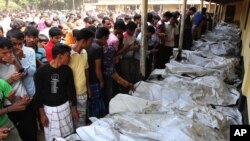NEW DELHI —
Bangladesh is mourning the deaths of victims of a blaze that engulfed a garment factory as concerns grow about unsafe conditions in the country’s thriving garment industry, which has become a major hub for global retailers.
Flags flew at half staff, factories were shut and prayers were held as Dhaka observed a day of mourning for the victims of a fire that ripped through the Tazreen factory on the outskirts of the city.
In a statement, U.S. retail giant Walmart, said that the factory had been making clothes sold in its stores without its knowledge. It says a supplier had subcontracted work to the plant without its authorization. Walmart says it will continue to work with the apparel industry to improve fire safety education and training.
Bangladesh’s apparel industry has become a key supplier to global retailers in recent years. But it is plagued with problems that are attracting international scrutiny.
Concerns are widespread about the poor wages paid to workers - $37 a month. But the recent fire has highlighted another problem - lax safety standards at hundreds of factories, as they rush to fill orders.
Zafrul Hasan at the Bangladesh Institute of Labor Studies in Dhaka says it is widely acknowledged that working conditions are inadequate at many factories.
“It is common knowledge there are many other premises where in case this type of accident takes place, there will be similar consequence," said Hasan. "Most of the factories, they are not equipped enough to deal with such hazards. Our electrical equipment are not up to the mark. It is a big management negligence.”
The cause of Saturday’s fire has not been established, but investigators suspect a short circuit in the electrical wiring. Survivors of the blaze say an exit door was locked, trapping hundreds of workers. Many jumped to their deaths. Survivors say fire extinguishers did not work and bundles of fabrics and yarn stacked in passages had ignited, turning escape routes into death traps.
Saturday’s blaze was the deadliest in a garment factory in Bangladesh, but there have been others. Some 200 people have died in fires in the garment industry since 2006.
Hasan says the industry needs more stringent regulation.
“The inspection mechanism in most cases, they don’t properly inspect whether everything is properly in place," said Hasan. "They say they do have enough manpower to inspect all the industries and sometimes the employers influence to make some kind of relaxation.”
Representatives of the Bangladesh garment industry and the government say sabotage could not be ruled out. But the latest blaze will bring the government under pressure to monitor safety lapses more closely in an industry that earns about $24 billion annually and accounts for about 80 percent of the country’s exports.
Flags flew at half staff, factories were shut and prayers were held as Dhaka observed a day of mourning for the victims of a fire that ripped through the Tazreen factory on the outskirts of the city.
In a statement, U.S. retail giant Walmart, said that the factory had been making clothes sold in its stores without its knowledge. It says a supplier had subcontracted work to the plant without its authorization. Walmart says it will continue to work with the apparel industry to improve fire safety education and training.
Bangladesh’s apparel industry has become a key supplier to global retailers in recent years. But it is plagued with problems that are attracting international scrutiny.
Concerns are widespread about the poor wages paid to workers - $37 a month. But the recent fire has highlighted another problem - lax safety standards at hundreds of factories, as they rush to fill orders.
Zafrul Hasan at the Bangladesh Institute of Labor Studies in Dhaka says it is widely acknowledged that working conditions are inadequate at many factories.
“It is common knowledge there are many other premises where in case this type of accident takes place, there will be similar consequence," said Hasan. "Most of the factories, they are not equipped enough to deal with such hazards. Our electrical equipment are not up to the mark. It is a big management negligence.”
The cause of Saturday’s fire has not been established, but investigators suspect a short circuit in the electrical wiring. Survivors of the blaze say an exit door was locked, trapping hundreds of workers. Many jumped to their deaths. Survivors say fire extinguishers did not work and bundles of fabrics and yarn stacked in passages had ignited, turning escape routes into death traps.
Saturday’s blaze was the deadliest in a garment factory in Bangladesh, but there have been others. Some 200 people have died in fires in the garment industry since 2006.
Hasan says the industry needs more stringent regulation.
“The inspection mechanism in most cases, they don’t properly inspect whether everything is properly in place," said Hasan. "They say they do have enough manpower to inspect all the industries and sometimes the employers influence to make some kind of relaxation.”
Representatives of the Bangladesh garment industry and the government say sabotage could not be ruled out. But the latest blaze will bring the government under pressure to monitor safety lapses more closely in an industry that earns about $24 billion annually and accounts for about 80 percent of the country’s exports.








